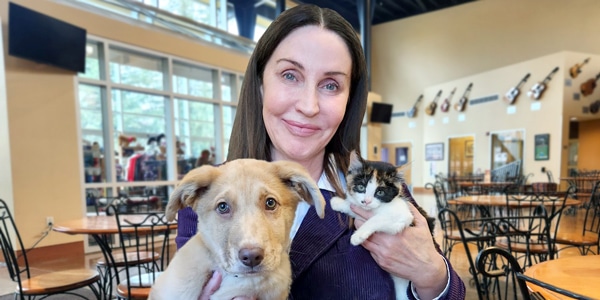Life during the pandemic has required new routines and adjustments for everyone. Whether we’ve worked from home, avoided group gatherings, or put travel plans on hold, we’ve all spent more time at home this past year. With vaccinations extending to Californians over age 16 on April 15, we are hopeful for a return to normalcy soon. Well, almost all of us. There are some family members who might not be as excited about this change: our furry companions.
Most animals have grown accustomed to having their people around a lot, and more Americans than ever are new pet parents. Animal shelters saw a boom in adoption interest, and #PandemicPuppy was trending on social media. Additionally, pet guardians spent a record-breaking amount on their companions during the pandemic, exceeded $100 billion in sales for the first time. All of these trends add up to the fact that as we’ve dealt with the crushing realities of COVID-19, we’ve sought animals to provide us with love, support, and hope. As we prepare to return to the office and pre-pandemic activities, we must also prepare our loyal companions.
Adjusting to your increased absence could cause your pet stress and bring out undesirable behaviors. Bay Area animal welfare experts recommend training your pet to get accustomed to spending more time by themselves with the goals of a) proving to your pet that they are safe, and b) showing them that alone time can be fun!
With proper management and training, separation distress and anxiety can be avoided. Here are four easy things to start now:
1) Low-Key Departures and Arrivals
During the 10 to 15 minutes before you leave home or upon arrival, strive for a calm, neutral atmosphere. Avoid hugging, kissing, petting, or high-energy play. We know it’s very hard, but it is best to simply ignore your pet.
2) Enrichment & Games
When left alone, pets often find ways to entertain themselves. To provide appropriate outlets for your pet’s energy, experiment with long-lasting treats and creative feeding methods for mealtime. You’ll want to test these out before you leave your pet alone with them to allow time to evaluate that your pet can safely use them without you. It will also help you find which treats your pet especially loves! Once you find their favorites, only give it to them before departing the home. This will keep it extra special and help your pet look forward to being left alone.
Some ideas include: food dispensing toys, food puzzles, interactive feeding mats (affectionately called snuffle mats), and hiding kibble/treats in cardboard or paper products that your pet can tear apart (like cereal boxes, paper towel rolls, egg cartons, or paper bags).
3) Practice Alone Time
Practicing being alone is important for all pets. Identify a comfortable, safe area for their alone time. This might be in a room, an area separated by a baby gate, or a dog crate. (More about crate training below!) At least once a day, set your pet up with a long-lasting treat or food puzzle, some of their favorite toys, a comfy bed, and water. Begin by only leaving them alone for short periods of time. Just 5-10 minutes is the perfect place to start! You can vary between leaving them completely alone and sitting nearby while not engaging. Vary
the length of absences and time of day so it’s not predictable (pets can get very good at anticipating the schedule).
4) Crate Training
If approached correctly, crate training is an excellent way to provide your dog with safety and a sense of security when left alone, while avoiding behaviors like destructive chewing or inappropriate toileting. Teaching a dog to love their crate is also extremely useful when traveling or during emergencies.
Create a positive association with the crate by leaving the door open, or remove the door completely, during the beginning stages of training. Also consider the location of the crate. Some dogs prefer to rest in quiet spaces in the home, while others prefer spaces where they can see the action. Audition what might be best for your dog.
As you advance in training, it’s important to help your dog keep a healthy relationship with the crate by maintaining their trust that they are in a safe space and they’re going to get out fairly soon.
Just as our pets have provided for us this past year, we must provide for them by getting them prepared for a post pandemic life. By adding short, daily training sessions into your pet’s day now, you will help them tremendously in the months to come.



